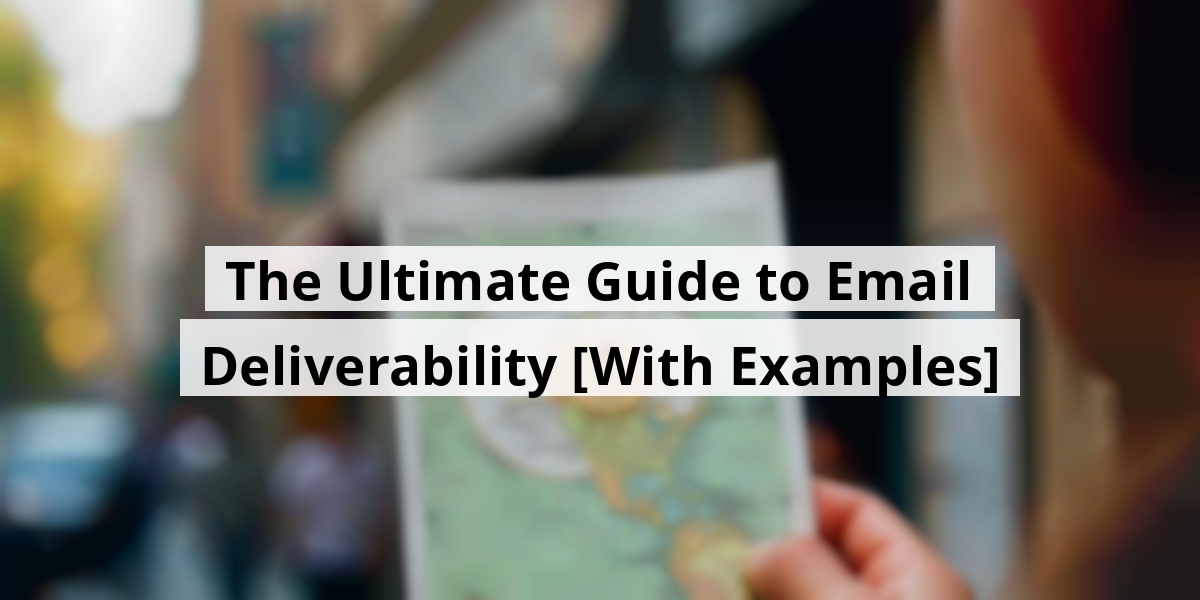 LIMITED SPOTS
All plans are 30% OFF for the first month! with the code WELCOME303
LIMITED SPOTS
All plans are 30% OFF for the first month! with the code WELCOME303

 LIMITED SPOTS
All plans are 30% OFF for the first month! with the code WELCOME303
LIMITED SPOTS
All plans are 30% OFF for the first month! with the code WELCOME303


Now we are going to discuss the nitty-gritty of email deliverability—yes, that mysterious dance that your emails do before landing in someone’s inbox. Spoiler alert: it’s not as simple as just sending an email.
Alright, let’s simplify this whole thing. When we hit send, our emails don’t just teleport into existence. It’s like sending a child off to school—there are checks and balances all over the place! Email providers like Gmail and Outlook get to scrutinize your message before it even thinks about settling into an inbox.
Here's a fun analogy: imagine your email is a VIP at a party. If the bouncers (the ISPs and email servers) don’t like its vibe or think it’s going to cause trouble, they won't let it in. So what’s on their checklist?
It’s a bit unpredictable—think of it like weather forecasting. Some days you’ll wake up and find a sunny sender reputation, while on other days, you might be looking for an umbrella.
Every time someone marks your email as spam, it’s like they’re leaving bad Yelp reviews for your restaurant. Each report can slap a big ol’ "questionable sender" sticker on your profile. Too many, and you might find your emails getting the heave-ho.
The golden rule here? Send emails that feel personal and relevant. It’s like inviting the neighbor over for cookies—make it feel neighborly, not like a sales pitch!
Be careful with your word choices! No one wants to open an email that sounds as if it's yelling “FREE!!” at them like a used car salesman. Keep it casual—people are more likely to engage over a warm cup of coffee than hyperbole.
Since GDPR came knocking last year, everyone got a little more uptight about spam filtering. It’s a good thing, but it also makes our jobs as senders a bit like walking a tightrope. No one wants to fall into that abyss!
Here’s a spicy tip: If you start loading your emails with links and images, you’re basically putting up a neon sign that says “SPAM!” Aim for no more than two links, and one image tops—less is more.
If you're starting fresh with a new domain, it’s best to keep links out altogether at first. Get a little interaction before throwing in those hyperlinks like confetti!
Getting blacklisted is like being grounded after sneaking out. And it’s no walk in the park to get back on the invite list. If the email police catch wind of spammy behavior from your domain, you could be in hot water.
And hey, if you’ve got a shiny new domain, it’s especially susceptible to low engagement penalties. Think of it as a new kid in school—if nobody likes them right away, they might never fit in!
So how do we avoid being the digital outcast? Simple: Send delightful, genuine, relevant emails! Your goal should be to gain trust instead of scaring everyone with spammy vibes.
Remember, quality always trumps quantity. The secret sauce of successful email deliverability is all about keeping it friendly, relevant, and above all, human.
Now we're going to talk about why keeping it simple in cold emails is not just wise, but downright essential. Getting an email from a stranger already raises a few eyebrows. When that email insists on making you click an attachment, well, that’s like saying, “Hey, come check out my mystery box!” But isn’t that just a bit too curious for our own good? It's clear why folks are wary. Remember the days when you’d hear about scams hiding behind attachments? It's like a bad movie, complete with digital robbers sneaking into your computer. So, when your potential client sees an attachment, it’s like waving a red flag. The same goes for images. Spammers use flashy pics to trick folks, making email providers block those little bits of creativity. Imagine you’re in a high-security lab, and someone tries to sneak in with a flashy briefcase—everyone’s going to look twice. And we totally understand the temptation to spice things up. After all, we’ve all received those emails that read more like a text message straight out of a 90s sitcom. But here’s the truth: your email isn’t about sealing the deal right off the bat. It’s like extending your hand for a handshake, hoping for an engaging conversation. People don’t want to dive into a treasure chest immediately. Gradually introducing them to your business is the smooth path to a relationship. If you really need to share some juicy info, ditch the attachments and fancy colors. Here are some nifty alternatives:
Now we’re going to discuss an important aspect of email marketing that might not make you the life of the party, but trust us, it’s crucial: safeguarding your email servers while ensuring those messages land in the right inboxes.



We all know sending a cold email is like trying to impress someone at a coffee shop—first impressions matter! When that email shoots into cyberspace, it’s not just flying blindly. It’s under scrutiny from both the recipient and their email provider.
Imagine your email is that awkward guy at the party. He’s gotta bring something interesting to get noticed, or he’ll end up in the “spam” corner, left unopened and alone!
Here’s the kicker: if your servers are hacked and hijacked by bad actors, you might as well be shouting “I’m a spammer!” from the rooftops. Nothing screams untrustworthy louder than a compromised email server. Recipients and their email providers won’t think twice—they’ll just mark you as spam.
If a third party gets into your email, they’re not just sending “Hey, check out this amazing offer!” emails. They can quickly taint your domain’s reputation, landing you on a blacklist faster than a cat video goes viral.
It’s like that time we thought we had bought a delicious pie, only to discover someone had filled it with mud. Your hard-earned reputation? Gone in a flash! That's why it’s crucial to maintain strong server security.
We’ve all invested time to establish a solid reputation for our IP address or sender domain. A security breach can wreak havoc on that reputation overnight.
So, how do we keep our emails flying high while keeping those pesky hackers at bay? Here’s a nifty little table to help us keep track:
| Best Practice | Description |
|---|---|
| Update Security Protocols | Stay informed about the latest security measures to protect your server. |
| Train Your Team | Ensure everyone understands phishing and security best practices. |
| Use a Reputable Email Service | Choose a provider known for prioritizing security and deliverability. |
So remember, preserving your reputation while ensuring your emails reach their destination go hand in hand. Keep those servers safe, and your emails will thank you!
Now we are going to talk about ensuring your cold emails actually land in the inbox where they belong, rather than getting lost in the spam abyss. Trust us, there's no worse feeling than pouring your heart into an email only for it to be tossed aside like yesterday's leftovers. Let's kick things off with some tips to boost that deliverability!
Think of your DNS settings like the foundation of a house. If it's shaky, the whole thing can come crashing down. We don't need a PhD in tech to remember a few crucial points. But those missing puzzle pieces could mean the difference between a radiant inbox and a dismal spam folder.
Key items include:
Keeping a squeaky-clean email list is key. We're talking about a slim, mean fighting machine of an email list. It should be targeted and scrubbed regularly. If your recipients are hitting the spam button more often than the snooze on their alarm clocks, you’re in trouble. Quick tip: verify your addresses and consider ditching any hard bounces without a second thought.
Using an email service like G Suite can make a world of difference. That’s your trusted buddy, not some random Gmail account. Trust us, a little professionalism goes a long way!
Why complicate things? A good DNS Manager like Cloudflare can tidy everything up faster than you can say “send.” Less fuss means more focus on your stellar email content.
So, you’ve got a new domain? Don’t sprint out of the gate. Start small, folks. Limit yourself to 50 emails a day and gradually ramp it up. Everyone loves a good warm-up session, right?
Here's an example of a pacing system we might suggest:
Oh, and don’t forget to include an easy way out for those who want to exit. A friendly unsubscribe option is better than being reported as spam. We all hate those unsubscribe hurdles, right? Just add a friendly “Reply with ‘unsubscribe’” at the end. Can’t get easier than that!
Engaging your audience is key. Aim for that open and response rate like a cat on a hot tin roof! Keep your content fresh, or you risk turning into yesterday’s news. AB testing is your best friend here—switch it up and see what sticks.
Would you rather hear from frank@yourcompany.com or info@company.com? Let’s be real, don’t ever go for do-not-reply@. Be authentic. Be human. Bring that warm, approachable vibe!
These steps give us a solid foundation. It's a long game—but with this roadmap, we can make sure our emails stand out and shine bright!
Now we are going to talk about some handy tools that can seriously boost our email deliverability game. Who doesn’t want their messages to actually hit the inbox instead of the dreaded spam folder, right? It's like throwing a party and no one shows up. So, let’s explore some options that can really help us shine!
Here’s a lineup of services to keep our emails on the right track:
Utilizing these tools is like having a backstage pass to the email world. Each one has its own strengths but together, they create a powerful support system. Imagine sending an email and *wha bam!* everyone sees it. It can boost engagement faster than caffeine on a Monday morning. Just picture it: you send out your updates, your audience is reading and clicking with enthusiasm. It’s like hitting the jackpot, letting us connect with our community more effectively. With tools that monitor deliverability, we’re in a much better spot—not wishing we had a magic wand to change things up. The satisfaction of seeing our hard work pay off? Priceless! So, let’s roll up our sleeves and make sure our emails don’t end up doing the cha-cha in spam folders. By using these tools, we can ensure our messages are getting the attention they deserve, like that friend who always asks for extra toppings on their pizza. They need to stand out, and so do our emails!
Now we are going to talk about email deliverability tests, and why they might feel like trying to find Waldo in a sea of stripes. It’s one of those things that can leave even the most seasoned marketers scratching their heads. After all, sometimes it feels like your carefully crafted emails are being treated worse than leftover pizza at a party!


We’ve got some highlights from an email test done by Julie Gulevich at GlockApps:
Email providers can act like bouncers at a nightclub, kicking out messages without so much as a good reason. We often wonder why our well-founded emails end up in the spam bin—plenty of potential clients but no invites to the inbox party.
To crack this enigma, Julie performed a fascinating case study using a message from MarketingProfs that flopped into her spam folder. Here’s a snapshot of her experience:
She decided to put her email to the test using different methods—like a scientist with a passion for emails! After sending the original message through her company’s SMTP server to a list of 78 addresses, she noted the rather disappointing results.
Next, Julie removed images from the email. “Let’s see how that goes,” she thought, sipping her coffee. But surprise, surprise—no change! The message still landed in the Promotions tab at Gmail and spam at Outlook. A head-scratcher for sure!
After testing various tweaks like altering footer content and removing links with less luck, she finally found a winner when swapping out the “Register” button for a single link. Bingo! Deliverability shot up like her caffeine levels after a long day. She went from 72.6% inbox rate to nearly 90% with her final revised email!
But then, there’s always that one troublemaker! Gmail kept sending her messages to Promotions, while Outlook kept waving its spam flag. So, she decided to switch gears completely by testing a different SMTP server. Remarkably, this adjustment dropped the spam rate to just 1.4%. Can I get a “Hallelujah!”?
What followed was nothing short of sensational—an inbox rate soaring to 90.4%! Julie hit jackpot status, and it should be her coffee shop talking point for the year!
Here’s the kicker: if you’re not testing your emails, it’s like showing up to a date in your pajamas and wondering why your date left early.
Keep an eye on your sender reputation; it’s like your email’s university degree. The metrics matter and it can make or break your emails
To sum it up, responding to those communication hiccups matters. Staying on top of your deliverability game should be like adding sprinkles to an ice cream cone—absolutely necessary!